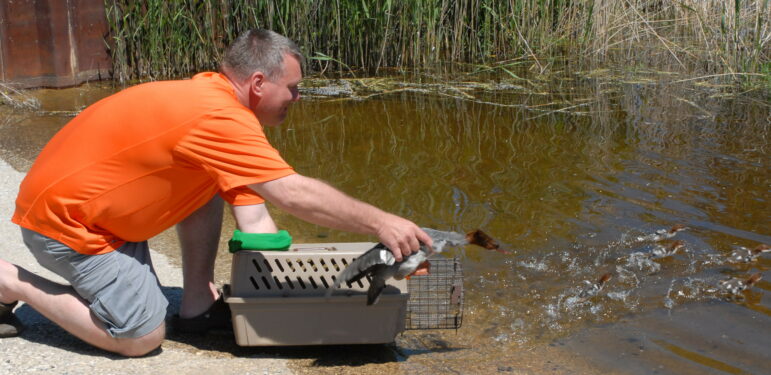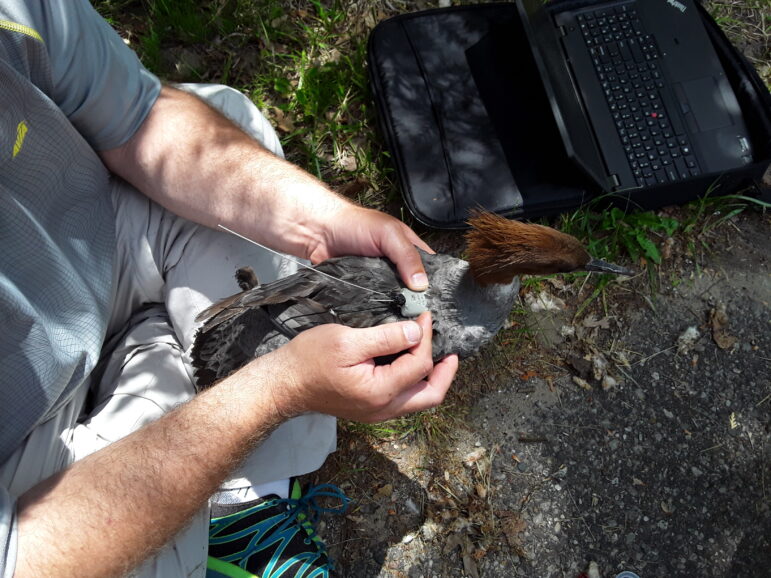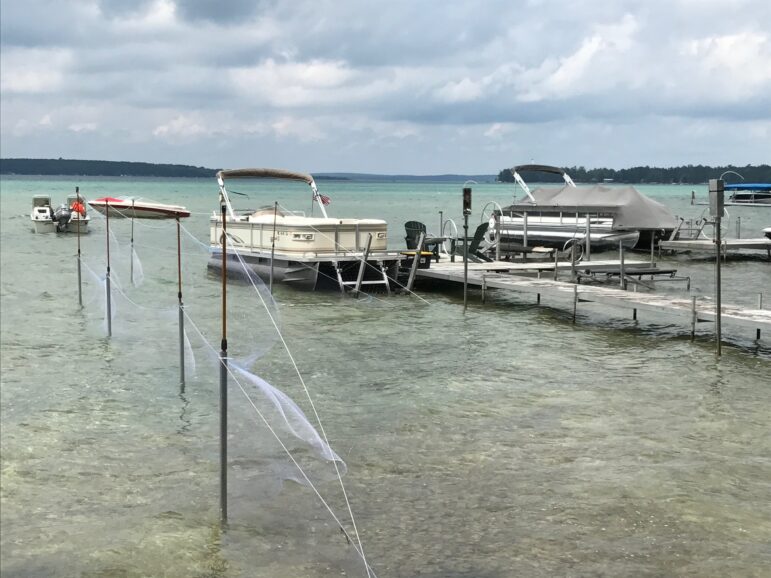
Curtis Blankespoor
A researcher relocates ducks to a new beach:By ALEX WALTERS
Capital News Service
LANSING — Jeff Stratton’s beloved Larks Lake left his feet and legs covered in hundreds of itchy red welts.
“It was horrible,” said Stratton, 68, “Crazy itchy. Crazy painful.”
The itching was caused by a tiny parasite that ran wild in the lake’s mergansers and snails. The predicament they cause is commonly called “swimmer’s itch.”
The parasites have long been managed ineffectively, with fruitless chemical remedies dumped into lakes and unscientific household treatments futilely employed by itchy swimmers.
Now a new study reveals an innovative method that researchers say is the first to truly combat the problem: Move the ducks.
Stratton is president of the Larks Lake Association, one of five Michigan lake associations to test the method for researchers.
Four years, one elaborate bird-trapping system and the relocation of hundreds of ducklings later, Stratton can once again enjoy swimming in the Emmet County lake he’s visited for 50 years.
The other associations are Higgins Lake in Roscommon County, Crystal Lake in Benzie County, Black and Douglas Lakes in Cheboygan County.
The method works by disrupting the parasites’ life cycle. They start their lives in mergansers, move to snails to grow, then move back into mergansers.
During that third step, the parasites often mistake humans for mergansers and burrow under their skin. Human bodies kill the parasites, but they stay under the skin, causing itching and painful welts.
The new method breaks that cycle by relocating mergansers to beaches without the snails, taking away the parasites’ chance to grow into something that could burrow in people.
The effort targets ducklings, which can contain 50 times more parasites than adults, says the study. The research was published in PLOS One, a journal of the Public Library of Science.
The theory was always sound, but designing the method and building the net system to execute it took years, said Curtis Blankespoor, a University of Michigan researcher who co-authored the study.
“They take off whenever you get close,” he said. “They’re wary, they won’t come to bait. It took us 20 years to develop a trapping method to effectively capture these ducks.”
Blankespoor and his team – Calvin University researcher Randall DeJong and his father, Hope College researcher Harvey Blankespoor – eventually landed on a large, v-shaped net that’s installed near the shore.
A boat pushes the birds into the net, where they’re picked up by people and placed in pet cages. The birds are tested for parasites and tagged.
They are then transported to new beaches – current Department of Natural Resources-approved sites include parts of Lake Michigan and Lake Huron – which lack the snails where the parasites grow.
Because of that, Blankespoor said, even heavily infected ducklings won’t create swimmer’s itch in the new waters because the parasites need the snails to grow.
The researchers try to move birds to unpopulated beaches because they fear people will misunderstand the method and “think we’re moving ducks and causing swimmer’s itch in new areas,” Blankespoor said.
“People don’t understand the biology, so they see us dumping ducks and they get a little panicky,” he said.
The relocated ducklings often nest for life at the new beaches, Blankespoor said. So, the first year involves a “labor-intensive treatment” for affected lakes, but eventually, there are few ducks to relocate as the population nests and reproduces on new beaches.
The study shows that over three years, the new method can prevent up to 99% of swimmer’s itch cases.
“Our method is a win win win,” he said. “It’s a win for the birds, it’s a win for the people swimming in the lake and it’s a win for the environment because you’re no longer dumping massive amounts of chemicals into the lake.”
The state suspended the program for two years because of concerns about avian flu. During that pause, the parasites increased greatly in the lakes that were being treated, Blankespoor said.
That jump in cases proves the method works, he said.
And this summer relocation efforts will resume because the Department of Natural Resources now acknowledges that the mergansers are poor hosts for avian flu, he said.
The researchers say they hope the study’s impressive results will help them secure funding to expand the project to more lakes, Blankespoor said.
“It’s a huge economic problem for (lakefront property owners) and a huge problem for folks just trying to enjoy lakes,” he said. “We now have a viable solution – it’s just a matter of convincing folks it will work and getting them to say, ‘Yes, we want this program on our lake.’”
Editor’s note: This story was corrected on April 30, 2024, to show that mergansers, not mallards, were responsible and to fix a spelling error.

Curtis Blankespoor
A researcher examines a merganser during the relocation process.
Curtis Blankespoor
A prototype of the net system used to trap mergansers for relocation.